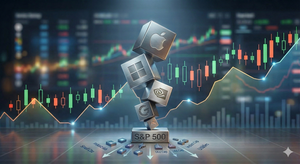
The U.S. economy finds itself at a critical juncture, as signals from The Conference Board's Leading Economic Index (LEI) point toward a sustained period of economic weakening. While the LEI's consistent downward trend has historically preceded recessions, The Conference Board maintains a nuanced outlook, forecasting a "significant slowdown" rather than an outright recession for the U.S. in 2025. This anticipation of decelerated growth, driven by a confluence of factors including consumer expectations, manufacturing orders, and policy impacts, has profound implications for financial markets, businesses, and everyday Americans.
The current economic landscape is characterized by a tug-of-war between leading indicators suggesting contraction and coincident indicators showing resilience. This divergence has created a complex environment where cautious optimism mixes with palpable concerns, prompting businesses and investors alike to re-evaluate strategies and brace for a potentially turbulent period of moderated economic activity.
Leading Economic Index Flashes Warning Signs Amidst Nuanced Outlook
The Conference Board's Leading Economic Index (LEI) for the U.S. has been on a persistent downward trajectory. In July 2025, the LEI dipped by 0.1% to 98.7 (2016=100), following a 0.3% decline in June. Over the six-month period from January to July 2025, the index contracted by 2.7%, a faster pace than the 1.0% decline observed in the preceding six months. This sustained negative six-month growth rate and a diffusion index below 50 have consistently triggered the LEI's internal recession signal for several consecutive months.
Specific components weighing heavily on the LEI include pessimistic consumer expectations for business conditions and weak new orders in manufacturing, alongside rising initial claims for unemployment insurance, although the latter saw a recent positive shift in July. These indicators collectively suggest diminishing economic momentum on the horizon. Despite these clear recessionary signals from the LEI, The Conference Board’s official stance remains cautious. They do not currently project a U.S. recession in 2025, instead forecasting real GDP growth of 1.6% year-over-year – a substantial deceleration from 2024.
The reasoning behind this nuanced perspective hinges on a decoupling of leading and coincident indicators. While the LEI forecasts future activity, the Coincident Economic Index (CEI), which reflects current conditions, has shown more resilience, rising by 0.2% in July 2025. Most of the CEI's components—including payroll employment, personal income, manufacturing and trade sales, and industrial production—improved, suggesting that current economic activity is still holding up. The anticipated economic weakening is attributed to specific headwinds like low consumer expectations, weak manufacturing orders, and the looming impact of tariffs, which are expected to manifest as slower consumer spending in the latter half of 2025. However, improvements in coincident indicators and some positive contributions from stock prices suggest the economy isn't experiencing a broad-based collapse indicative of a full recession.
Navigating the Headwinds: Potential Winners and Losers in a Slowing Economy
A period of significant economic weakening, even if it avoids a technical recession, will inevitably create a divide between industries and companies that can weather the storm and those that will struggle. Businesses providing essential goods and services are likely to prove more resilient, while those reliant on discretionary spending will face considerable headwinds.
Resilient Sectors and Potential Winners: Consumer Staples companies, which provide essential goods, typically see stable demand. Large supermarket chains like Kroger (NYSE: KR) could benefit as consumers opt to cook more at home. Beverage and snack giants such as PepsiCo (NASDAQ: PEP), with their diverse portfolio of household brands, often maintain consistent earnings. Similarly, producers of household cleaning and hygiene products like The Clorox Co. (NYSE: CLX) tend to experience steady demand. Discount retailers like Walmart (NYSE: WMT), Dollar General (NYSE: DG), and Dollar Tree (NASDAQ: DLTR) also tend to thrive as price-sensitive consumers seek out more affordable options.
The Healthcare sector is generally recession-resistant due to the non-discretionary nature of medical care. Pharmaceutical companies, such as Gilead Sciences Inc. (NASDAQ: GILD) and Regeneron Pharmaceuticals Inc. (NASDAQ: REGN), often see stable demand for their products. Health insurance providers like UnitedHealth Group (NYSE: UNH) also operate in a consistently high-demand sector. Utilities companies, including American Water Works (NYSE: AWK), providing essential services like water and electricity, are considered stable investments that often offer reliable dividends. Additionally, Auto Repair and Maintenance shops and Home Maintenance/DIY stores are expected to see increased business as consumers choose to repair existing assets rather than purchase new ones.
Vulnerable Sectors and Potential Losers: Consumer Discretionary industries are typically the hardest hit. Companies selling non-essential goods and services—automobiles, luxury goods, travel, and dining out—will likely see significant reductions in spending. The Automotive Industry, including manufacturers like Tesla (NASDAQ: TSLA), often faces declining sales during economic slowdowns. Restaurants and hospitality chains like Chipotle (NYSE: CMG) and Starbucks (NASDAQ: SBUX) have already reported weaker earnings due to consumers cutting back on non-essential outings.
The Real Estate and Construction sectors are highly sensitive to economic conditions, particularly rising interest rates and job insecurity. New home builders, for instance, are among the most vulnerable. Manufacturing faces a "perfect storm" of declining demand, supply chain disruptions, and reduced access to capital. While some areas of Technology (e.g., essential software, cloud computing) may be resilient, broader tech sectors reliant on business investment and advertising could face headwinds. For example, large tech companies often cut back on spending and delay projects, impacting smaller tech partners. The Financial Services sector can also be vulnerable due to tighter credit conditions and rising delinquencies, although some sub-sectors, like financial advisors, might see increased demand for their services.
Broader Implications: Reshaping Global Capital, Trade, and Policy
A sustained period of economic weakening in the U.S. carries significant global ramifications, influencing capital flows, international trade, and the policy landscape. One major trend is the potential shift in global capital flows, with capital possibly moving from perceived overvalued U.S. equities to more undervalued European markets. This could weaken the dollar and increase volatility in American stock markets, while European equity markets could attract substantial inflows.
The U.S. economic slowdown fits into broader industry trends marked by increasing economic nationalism and supply chain diversification. U.S. tariff policies, which saw the average applied U.S. tariff rate surge in 2025, are projected to reduce global GDP and contribute to inflationary pressures. This environment encourages companies to de-risk supply chains by exploring investments in regions like Southeast Asia and India, reducing dependence on China. This geopolitical tension and supply chain realignment create pervasive uncertainty for global businesses. A weaker dollar, a likely outcome of U.S. economic softening, could also boost commodity prices, benefiting resource-rich nations and commodity-producing companies.
The ripple effects extend to trade relations and global growth. Aggressive U.S. tariff policies are projected to reduce global GDP by as much as 1%, creating challenges for export-dependent economies, particularly in East Asia and the Eurozone. This could lead to monetary policy divergence among major central banks; while the Federal Reserve might cut rates to stimulate the U.S. economy, other central banks might follow different trajectories, impacting currency valuations and trade balances.
From a regulatory and policy standpoint, a weakening U.S. economy typically triggers responses from policymakers. The Federal Reserve is likely to consider interest rate cuts to stimulate growth, though this is complicated by persistent inflation, posing a "stagflationary dilemma." Governments may implement fiscal stimulus packages, but their capacity to do so is limited by existing high public debt levels. Trade policies are likely to lean further towards protectionism through tariffs, while potential deregulation in areas like climate and finance might be pursued to spur economic activity. Historically, achieving a "soft landing"—a slowdown without recession—is challenging. Comparisons to the "stagflationary" 1970s, where inflation and unemployment coexisted, highlight the risks of supply-side issues driving economic distress.
What Comes Next: Scenarios, Strategic Pivots, and Emerging Opportunities
The path forward for the U.S. economy remains uncertain, with several plausible scenarios emerging from the current signals. The short-term outlook for 2025 points to continued deceleration, with real GDP growth of 1.6% due to tariffs leading to higher consumer prices and slower spending. This slowdown is expected to persist into 2026, with further deceleration to 1.3%, as the full effect of tariffs plays out.
Potential Scenarios and Outcomes:
- Soft Landing: This remains The Conference Board's baseline. Economic growth cools sufficiently to curb inflation without triggering a recession, implying several quarters of growth below the economy's potential (around 2.0%) without outright contractions. This scenario relies heavily on the Federal Reserve's precise interest rate management.
- Mild Recession: The Conference Board’s Expectations Index, consistently below 80, signals a risk of a mild recession. This would entail a more significant pullback in discretionary spending, a rise in unemployment, and further pressure on corporate profit margins. Historical parallels with sluggish consumer spending mirroring the 2008-09 crisis reinforce this risk if the policy balance is mishandled.
- Prolonged Stagnation/Stagflation: This challenging scenario involves weak job growth coexisting with accelerating inflation. This risk is particularly elevated for the second half of 2025, especially if tariff-induced inflation limits the Fed's ability to cut rates. This outcome would lead to sluggish consumer spending and rising unemployment for an extended period.
Strategic Pivots for Businesses and Investors: Businesses must prioritize supply chain resilience, potentially through reshoring or diversifying supplier bases to mitigate trade tensions. Strategic investments in talent retention, AI for efficiency, and workforce upskilling are crucial. Companies heavily dependent on consumer spending will need to refine product offerings and marketing to capture shifting discretionary income.
Investors should consider diversification beyond the "Magnificent Seven" tech giants, with small- and mid-cap companies and value stocks potentially gaining traction. Allocating to hard assets and commodities can serve as an inflation hedge, while focusing on companies with strong pricing power and sustainable margins is key. Sector rotation will be vital, with consumer staples potentially outperforming discretionary goods. Energy, healthcare, and infrastructure plays may show resilience. Identifying undervalued sectors with strong cash flow and policy-driven catalysts, such as small-cap and real estate, could offer opportunities.
Market Challenges and Opportunities: Challenges include persistent market volatility, consumer weakness due to inflation and rising credit utilization, higher borrowing costs, and potential labor market strain. The high U.S. corporate debt and market concentration within the S&P 500 also pose risks. Opportunities may arise in growth equities and commodities if the Fed cuts rates, undervalued small-cap and value stocks, and a potential revival in the real estate sector. Resilient sectors like energy, healthcare, and infrastructure plays could offer stable growth.
Conclusion: A Delicate Balance and Vigilant Path Ahead
The U.S. economy is navigating a delicate balance, with leading indicators signaling a clear path to weakening, yet The Conference Board holding firm against a full recession forecast for the immediate future. This distinction, though subtle, has significant implications, suggesting a period of constrained growth and heightened caution rather than an outright collapse. The interplay of pessimistic consumer expectations, manufacturing slowdowns, and the pervasive impact of tariff policies are the primary drivers of this anticipated deceleration.
Moving forward, the market will remain acutely sensitive to incoming economic data, particularly the interplay between inflation, employment, and consumer spending. The Federal Reserve’s monetary policy decisions will be paramount, as it attempts to thread the needle between cooling inflation and avoiding a deeper economic downturn. Investors should brace for continued volatility and consider defensive positioning, focusing on companies with robust balance sheets, consistent demand, and proven resilience in challenging environments.
Key takeaways include the importance of adaptive strategies for businesses, the potential for sector rotations in investment portfolios, and the ongoing global ramifications of U.S. economic health. While a "soft landing" remains a possibility, the risks of a mild recession or even prolonged stagnation cannot be entirely dismissed. Vigilance, flexibility, and a deep understanding of macroeconomic signals will be crucial for navigating the evolving economic landscape in the coming months.






